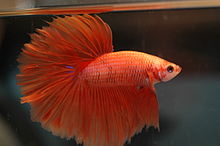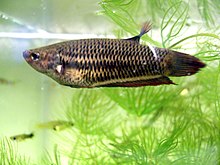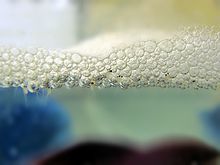| Siamese fighting fish |
|
 Selectively bred halfmoon male - This Male is either displaying for the sake of it or trying to ward off a rival/lure a mate. Selectively bred halfmoon male - This Male is either displaying for the sake of it or trying to ward off a rival/lure a mate. |
 |
| Naturally
occurring female - This female is stressed, this can be seen by the
white colour and slight black banding along her body known as "stress
stripes". When not stressed she would be a dark red/blue colour. Another
sign to show she is stressed/ill is that she has her fins clamped up. |
| Conservation status |
Domesticated
|
| Scientific classification |
| Kingdom: |
Animalia |
| Phylum: |
Chordata |
| Class: |
Actinopterygii |
| Order: |
Perciformes |
| Family: |
Osphronemidae |
| Genus: |
Betta |
| Species: |
B. splendens |
| Binomial name |
Betta splendens
Regan, 1910 |

A pair sp


awning under a bubble nest in a breeder's tank.

1-day old larvae in a bubble nest, note that their yolk sacs have not
yet been absorbed - when they are fry it is the only time that the betta
relies entirely on its gills to breathe.

Betta splendens fish build bubble nests of varying sizes.

A 15-day old free-swimming fry, infected with Piscinoodinium sp. (
Velvet disease),
a common fry-killer of this species in captivity - although in adults
this can be treated - in fry it is much harder as they are very
intolerant to medications and water imbalance
Male bettas flare their gills, twist their bodies, and spread their
fins if interested in a female. The female will darken in colour, then
curve her body back and forth as a response. Males build
bubble nests
of various sizes and thicknesses at the surface of the water. The act
of spawning itself is called a "nuptial embrace", for the male wraps his
body around the female; around 10–41 eggs are released during each
embrace, until the female is exhausted of eggs. The male, in his turn,
releases milt into the water, and fertilization takes place externally.
During and after spawning, the male uses his mouth to retrieve sinking
eggs and deposit them in the bubble nest (during mating the female
sometimes assists her partner, but more often she will simply devour all
the eggs that she manages to catch). Once the female has released all
of her eggs, she is chased away from the male's territory, as it is
likely that she'll eat the eggs due to hunger.
[6]
The eggs remain in the male's care. He carefully keeps them in his
bubble nest, making sure none fall to the bottom, repairing the bubble
nest as needed. Incubation lasts for 24–36 hours; newly-hatched larvae
remain in the nest for the next 2–3 days until their yolk sacs are fully
absorbed. Afterwards the fry leave the nest and the free-swimming stage
begins. It is common practice in the aquarium hobby to remove the male
at this point, so that he would not eat his young (although it has been
suggested that this danger is overrated). In this first period of their
lives,
B. splendens fry are totally dependent on their gills; the
labyrinth organ
which allows the species to breathe atmospheric oxygen typically
develops at 3 to 6 weeks of age, depending on the general growth rate,
which can be highly variable.
B. splendens can reach sexual maturity at an age as early as 3 months.
B. splendens can be hybridized with
B. imbellis,
Betta sp. Mahachai and
B. smaragdina, though with the latter the fry tend to have low survival rates. As well as these hybrids within the
Betta genus, there have been reports of the inter generic hybridizing of
Betta splendens and
Macropodus opercularis- the Paradise Fish.
[edit] Colours


A dalmatian orange male.
B. splendens have been affectionately nicknamed "The Jewel of
the Orient" due to their beauty and wide range of colours which are
produced through
selective breeding[citation needed].
Wild fish exhibit strong colours only when agitated.
[citation needed] Breeders have been able to make this colouration permanent, and a wide variety of hues
breed true.
Colours available to the aquarist include red, blue, turquoise, orange,
yellow, green, bright blue with pink highlights, cream and even true
white (the "Opaque" white, not to be confused with albino). The shades
of blue, turquoise and green are slightly
iridescent,
and can appear to change colour with different lighting conditions or
viewing angles; this is because these colours (unlike black or red) are
not due to
pigments, but created through refraction within a layer of translucent
guanine
crystals. Breeders have also developed different colour patterns such
as marble and butterfly, as well as metallic shades like copper, gold,
or platinum (these were obtained by crossing
B. splendens to other
Betta species).
Breeders around the world continue to develop new varieties. Often,
the male of the species are sold preferentially in stores because of
their beauty, compared to the females. Recently, breeders have developed
in females the same range of colours previously only bred in males.
Females never develop fins as showy as males of the same type and are
often more subdued in colouration.
The true albino betta has been feverishly sought after since one
recorded appearance in 1927, and another in 1953. Neither of these were
able to establish a line of true albinos. In 1994, a hobbyist named
Tanaka claimed to have successfully bred albino bettas.
[7]
[edit] Finnage and scale variations

A metallic, double-tail male


A crowntail male
Breeders have developed several different finnage and scale variations:
- VeilTail (extended finnage length and non-symmetrical tail; caudal fin rays usually only split once)
- CrownTail (fin rays are extended well beyond the membrane and
consequently the tail can take on the appearance of a crown; also called
fringetail)
- CombTail (less extended version of the crown tail, derived from breeding crown and another finnage type)
- Half-Moon (caudal fin that forms a 180 degree angle) The edges of the tail are crisp and straight.
- Over-Half-Moon (caudal fin that is in excess of the 180 degree
angle) by product of trying to breed half-moons; can sometimes cause
problems because the fins are too big for the fish to swim properly. If
the fish is able to swim properly, however, OHM's are sought after to
breed with Super Deltas to try to get Half-Moons.
- RoseTail (halfmoon variation with so much finnage that it overlaps and looks like a rose)
- Short-Finned fighting style (sometimes called "plakat")
- Double-Tail (the tail fin is duplicated into two lobes and the dorsal fin is significantly elongated; the two tails can show different levels of bifurcation depending on the individual)
- Delta Tail (tail spread less than that of a half-moon with sharp edges)
- HalfSun (Combtail with caudal fin going 180 degrees, like a halfmoon)
- Dragon Scale (scales which are solid rich colour; colours tend to be mostly white)
[edit] Behavior


A male attacking and flaring at his reflection in a mirror.
Males and females flare or puff out their
gill covers (opercula) in order to appear more impressive, either to intimidate other rivals or as an act of
courtship.
Other reasons for flaring their gills is that they are startled by
movement or change of scene in their environment. Both sexes will
display horizontal bars (unless they are too light a colour for this to
show) if stressed or frightened; however, such a colour change, common
in females of any age, is very rare in mature males. Females often flare
their gills at other females, especially when setting up a
pecking order.
Flirting
fish behave similarly, with vertical instead of horizontal stripes
indicating a willingness and readiness to breed (females only). In fact
the fish flare their fins and gills as a sign of aggression or flirting
with other fish. Bettas sometimes require a place to hide, even in the
absence of threats. They may set up a territory centred on a plant or
rocky alcove, sometimes becoming highly possessive of it and aggressive
toward trespassing rivals.
The aggression of this fish has been studied by
ethologists and
comparative psychologists.
[8]
Siamese fighting fish will even respond aggressively to their own
reflections in a mirror; use of a mirror avoids the risk of physical
damage inherent in actual conflict, although it can lead to stress in
some individuals. Like other fish, the fighter may respond to the
presence of humans and become trained to respond to feeding cues (such
as a hand placed over the water's surface). They are quite curious and
will watch humans going about their business nearby. When plant leaves
reach the surface, they are useful for males to base their bubble nests
on. Ethical issues are still debated with the growing activity of
pitting males together. Audience bet on the fishes while the bettas
savagely attack each other. Males are isolated from one another to avoid
such aggression.
[edit] Tanks and tank mates
In captivity, male
B. splendens are best housed alone
[9]
since, as their name "fighting fish" implies, they will aggressively
attack and kill (or be killed by) another male in their territory.
Putting female and male specimens together is not recommended either
(except for breeding, in which the female should be removed immediately
after the process) as they will often attack each other. Female bettas
can sometimes be kept together in groups of three to seven in larger
tanks with hiding places for the less-aggressive females. Male bettas
have been successfully housed in large community tanks with other fish
that have similar tropical temperature and water quality requirements.
Platies, corycats, and African dwarf frogs work best with this fish as
well as neon/cardinal tetras and white cloud mountain minnows. Other
fish species may be kept in the same tank as a betta, provided the fish
does not have long fins that would cause the betta to mistake it for a
threatening male betta, and provided the fish isn't significantly
smaller than the betta. Endlers (Poecillia wingei) should be fine as
long as their fins are small. Bettas might harass and nip at other
species that are colourful or have long, flowing fins, and may be nipped
at by aggressive tank mates. Careful research should be carried out
before selecting tank mates.
[10] Although many retail pet shops market very small "bowls" for
B. splendens
and the fish can, in fact, survive in a small container for periods of
time, for optimum health and vigour larger tanks should be considered. A
commonly accepted minimum tank volume is 4 to 5 liters.
[11] Recommended tank volume is 20 to 40 liters (5-10 US gallons).
Although commonly called "betta," that is the name of a genus.
B. splendens
is more accurately called by its scientific name or Siamese fighting
fish, to avoid confusion with the other species in the genus. The word
betta is not pronounced "beta" like the Greek letter, with the "e"
sounding like an "a", but with the "e" actually sounding like an "e."
[edit] In popular culture
- In the 1963 James Bond movie From Russia with Love, the strategy of the criminal organization SPECTRE
is compared to three Siamese fighting in the same tank: Two will fight
each other to the death while the third will wait its turn to fight the
exhausted victor, symbolizing the conflict between the USA and the
Soviet Union, with SPECTRE as the fish that waits.
- The title of S.E. Hinton's 1975 novel Rumble Fish, is an eponymous reference to what two brothers call the breed. In Francis Ford Coppola's 1983 film adaptation, everything appears in black and white except the Siamese fighting fish.
- The Siamese fighting fish has been used as the default background in the beta and release candidate versions of the 2009 Windows 7
operating system, in an apparent reference to the name "Betta." A
similar wallpaper and boot-screen also used in the pre-releases of Windows 8.
- A Siamese fighting fish features as a clue in a murder in 2009 film Bad Lieutenant: Port of Call New Orleans.
- Milo, one of the main characters in the Disney Channel's 2010 series, Fish Hooks, is a Siamese fighting fish.
[edit] References
Cupang
Dari Wikipedia bahasa Indonesia, ensiklopedia bebas
(Dialihkan dari
Ikan cupang)
(
Betta sp.) adalah ikan
air tawar yang habitat asalnya adalah beberapa negara di
Asia Tenggara, antara lain
Indonesia,
Thailand,
Malaysia, dan
Vietnam.
Ikan ini mempunyai bentuk dan karakter yang unik dan cenderung agresif
dalam mempertahankan wilayahnya. Di kalangan penggemar, ikan cupang
umumnya terbagi atas tiga golongan, yaitu cupang hias, cupang aduan, dan
cupang liar. Di Indonesia terdapat cupang asli,salah satunya adalah
Betta channoides yang ditemukan di Pampang,
Kalimantan Timur.
Ikan cupang adalah salah satu ikan yang kuat bertahan hidup dalam
waktu lama sehingga apabila ikan tersebut ditempatkan di wadah dengan
volume air sedikit dan tanpa adanya alat sirkulasi udara (
aerator), ikan ini masih dapat bertahan hidup.
Perkembangan variasi ditinjau dari segi bentuk dan warna terbilang
pesat dalam beberapa generasi terakhir. Beberapa jenis cupang yang
dikenal sekarang ini:
[3]
Ikan cupang di atas dikenal sebagai
mouth breeder yaitu ikan
cupang yang mengerami telurnya di dalam mulut, sedangkan kelompok di
bawah ini yang merupakan kerabat ikan cupang (betta), yang membangun
sarangnya dengan busa (bublle nest)
- Betta akarensis (Sarawak Betta)
- Betta coccina (Clorat's Betta)
- Betta bellica (Standard's Betta)
- Betta tesyae (Peaceful Betta)
- Betta smaragdina (Emerald Betta)
- Betta imbelis (Slugger's Betta)
- Betta splendens (Siamese Fighting Fish)
Jenis ikan cupang lain yang dikenal sebagai:
Cupang hias dibagi lagi menjadi beberapa jenis, yaitu:
- Halfmoon (setengah bulan), cupang jenis ini memiliki sirip
dan ekor yang lebar dan simetris menyerupai bentuk bulan setengah. Jenis
cupang ini pertama kali dibudidaya di Amerika Serikat oleh Peter Goettner pada tahun 1982.
- Crowntail (ekor mahkota) atau serit, cupang jenis ini pertama kali dibudidayakan oleh seorang peternak cupang yang tinggal di daerah Jakarta barat, tepatnya didaerah slipi skitar tahun 1968[rujukan?](
oleh karena itu slipi di sebut juga sebagai pusat ikan cupang hias,nya
indonesia ) Ciri utamanya adalah sirip dan ekornya yang menyerupai sisir
sehingga di namakan serit.
- Double tail (ekor ganda)
- Plakat Halfmoon
- giant (cupang raksasa), cupang jenis ini merupakan hasil
perkawinan silang antara cupang biasa dengan cupang alam, cupang jenis
ini ukurannya bisa mencapai 12 cm
[sunting] Galeri Cupang
-
Kampffisch betta splenden
-
-
-
-
-
-






















